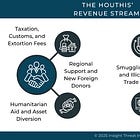Lebanon has taken the unprecedented step of closing Hizballah’s bank, Al Qard al Hassan, capping off months of incremental restrictions. The central bank first banned exchange house interactions with the entity in July, then prohibited all transactions earlier this month. Now the bank itself is reportedly closed. The move coincides with US sanctions on seven of its senior officials.

While this is being touted as a significant disruption to Hizballah’s financial operations, and by extension, the wider Axis of Resistance, the impact on many of the members in the axis will likely be minimal. For instance, the Houthis’s finances are diversified, domestically anchored, and increasingly shielded from Lebanese or even regional pressures. Much of their funding is raised and spent locally, and while they likely benefited from the Al Qard al Hassan network (as all members of the Axis of Resistance did), they never relied exclusively on it.
That said, Al Qard al Hassan played an important role in Iran’s hybrid threat finance network. Its closure eliminates a semi-licit node long used for transactions and to move funds across jurisdictions with some degree of plausible deniability. In the short term, this will stress the network. In the medium term, Iran’s threat finance network will exploit alternative pathways: informal value transfer systems, cryptocurrency, crypto-hawala, and deeper entrenchment in the shadow banking ecosystem. The bank might even be reconstituted under a different name or cover.
Our terrorist financing analysis course caters to researchers, intelligence, law enforcement, and compliance professionals to help them learn about terrorist financing, and analyze suspicious patterns and activities more effectively. Sign up today!
Iran provides financial support to its regional proxies (Hizballah, the Houthis, Hamas, Iraqi militias, etc.) through a mix of formal and informal financial architecture that allows Iran to channel support with limited exposure. Shutting down one node, especially one with semi-legitimate status, adds friction but doesn’t collapse the system. What it does do is force the network further underground. As nodes like Al Qard al Hassan are lost, the architecture tilts more toward opaque and decentralized financial instruments: crypto wallets, unregulated hawaladars, and the use of shell companies in permissive jurisdictions.
It also makes the network more difficult to monitor and disrupt. Formal nodes serve as pressure points; once they’re gone, enforcement agencies lose access to transaction data and choke points and have to find new nodes to exploit.
So, while this move is politically and symbolically significant, the operational impact is limited unless it's paired with broader enforcement across the rest of the hybrid network. As with past disruptions, the real question is whether the network adapts faster than the enforcement mechanisms targeting it. So far, history suggests it will.
© 2025 Insight Threat Intelligence Ltd. All Rights Reserved.
This newsletter and its contents are protected by Canadian copyright law. Except as otherwise provided for under Canadian copyright law, this newsletter and its contents may not be copied, published, distributed, downloaded or otherwise stored in a retrieval system, transmitted or converted, in any form or by any means, electronic or otherwise, without the prior written permission of the copyright owner.




